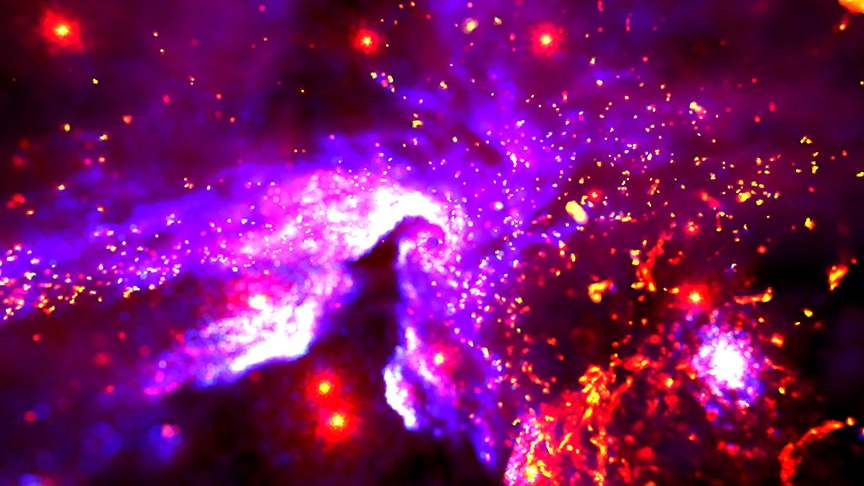Visit the Milky Way's supermassive black hole with 'Galactic Center VR' visualization (video)
A new virtual reality experience lets you fly closely, but safely, towards the supermassive black hole embedded in the heart of our galaxy, the Milky Way.
The "adventure" visualization is called Galactic Center VR and is based on data from NASA's Chandra X-Ray Observatory, as well as other telescopes. The latest iteration allows viewers to see 500 years of evolution at Sagittarius A* (Sgr A*), the black hole in the Milky Way's Center. You can view the experience for free from Steam or Vivepoint.
The Sgr A* simulation is based on modeling from 25 extremely bright and massive objects, called Wolf-Rayet stars. Similarly to supernovas, or star explosions, Wolf-Rayet stars push their outer layers of material into space. At Sgr A*, this star-shedding activity produces supersonic winds, and the material is picked up in the black hole's gravity.
Video: Last 500 years around Milky Way's supermassive black hole
Related: Something weird is up with the black hole at the Milky Way's center
"When the winds from the Wolf-Rayet stars collide, the material is heated to millions of degrees by shocks — similar to sonic booms — and produce copious amounts of X-rays," NASA said in a statement. "The center of the galaxy is too distant for Chandra to detect individual examples of these collisions, but the overall X-ray glow of this hot gas is detectable with Chandra's sharp X-ray vision."

The visualization displays about three light-years of space centered on Sgr A*, but the black hole is not shown to scale. It is enlarged by about 10,000 times to make it more visible; otherwise, NASA said, Sgr A* would only occupy a single pixel of space in the simulation.
Users can move around the simulation in different directions, playing with aspects such as the playback speed and the number of Wolf-Rayet winds shown. The visualization shows the Wolf-Rayet stars in white, with their orbits represented in gray. X-ray emissions are shown in blue and cyan, and wind material is portrayed in red and yellow. The overlap of wind materials and X-ray emissions is shown in purple.
Get the Space.com Newsletter
Breaking space news, the latest updates on rocket launches, skywatching events and more!
Chandra is one of the two remaining NASA "Great Observatories" that launched to space in the 1990s and 2000s to observe astronomical phenomena in different wavelengths of light. The other observatories are the Hubble Space Telescope (still active), the Compton Gamma Ray Observatory (decommissioned in 2000) and the Spitzer Space Telescope (retired earlier this year).
- Visit the heart of the Milky Way in this 360-degree, 4k simulation (video)
- Our Milky Way galaxy: a traveler's guide (infographic)
- The strangest black holes in the universe
Follow Elizabeth Howell on Twitter @howellspace. Follow us on Twitter @Spacedotcom and on Facebook.
OFFER: Save 45% on 'All About Space' 'How it Works' and 'All About History'!
For a limited time, you can take out a digital subscription to any of our best-selling science magazines for just $2.38 per month, or 45% off the standard price for the first three months.
Join our Space Forums to keep talking space on the latest missions, night sky and more! And if you have a news tip, correction or comment, let us know at: community@space.com.

Elizabeth Howell (she/her), Ph.D., was a staff writer in the spaceflight channel between 2022 and 2024 specializing in Canadian space news. She was contributing writer for Space.com for 10 years from 2012 to 2024. Elizabeth's reporting includes multiple exclusives with the White House, leading world coverage about a lost-and-found space tomato on the International Space Station, witnessing five human spaceflight launches on two continents, flying parabolic, working inside a spacesuit, and participating in a simulated Mars mission. Her latest book, "Why Am I Taller?" (ECW Press, 2022) is co-written with astronaut Dave Williams.
-
IA PUC VR ReplyWolfshadw said:You should state in the article that only the HTC VIVE is supported.
-Wolf sends
Hi, we are working on getting other VR headsets supported as well. For parties interested in creating their own bindings for the Index, Rift, or WMR, please see our post on our Steam communities discussion board: https://steamcommunity.com/app/1240350/discussions/0/2298472007785939739/










